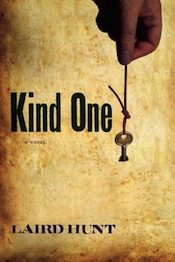
Released from Coffee House Press in September 2012 and recently honored as one of four PEN/Faulkner Award finalists, Laird Hunt’s Kind One is a crushing and beautiful book. Taking place over the span of a century, 1830-1930, Kind One weaves together the lives of Linus Lancaster, his second wife Ginny, and his five farm and house hands, following how they brawl and bend from Indiana to Kentucky, through death and abuse, and into a future loaded with loss, defiance, and perseverance.
Novels of the south, of slavery and racism, of shackles and incest, are not easy. The subject matter steeps with the awful reality of our shared history, and books of this focus can be prone to reliance on that darkness itself, using the inherent bluster of the content to ratchet up a novel’s intensity without equalizing the linguistics of it, the writing. In Kind One Laird Hunt takes the opposite tack, manipulating the reader’s path both at the narrative and the sentence level, creating a complex and interwoven tale of anguish and redemption.
Across the intricate and rifle-fast pace of Kind One, Hunt creates a narrative that bounces in and out of time, re-telling pasts, and skipping forward to futures, all with enormous faith in the reader to maintain their stride while keeping it all straight. Even in the stories-within-the-story, like those Ginny’s later employer/savior/love Lucious Wilson tells, they often end in narrative introspection:
You hear something like that and it walks out the door with you. It follows you out the door to your work and your rest then jumps into your head and runs around inside it like a spider. You think these isn’t much to a story like that and you think you’ve forgotten it, and a week later it is there. A year later it is there. Half a whole lifetime later it is there. Something like that gets in you and gets started and it doesn’t stop.

The history of the U. S. is difficult and unbound and rife with ends that loop back on themselves, stories as horrifying as they are unbelievable, and the structure of Kind One grants that history not one ounce of exception.
Hunt’s ability to rupture and replicate what we know of the south and our own jagged past is also exemplified at the sentence level of Kind One, where the meticulous nature of his craft is tremendously realized. As in this description of side-character Bennett Marsden: “His hair was greased up from his hat and his dirty fingers so it looked like three quarters of a crow’s wing had fallen out of the blue sky and smacked him on his head” or this explanation of Ginny Lancaster’s school days as a new teacher:
Not a body in the room knew its letters to speak of so we started there. My trick about it was to pretend I was in that old school room of mine, that room where I had written my story and been called to the front of the class. I could even bring up the pine smell of that place and it wasn’t a thing to imagine that my old teacher was standing just behind me, with a little smile, whispering to me about what to say. We did letters and took a peek at numbers and sang songs and another few of those days mooed and grazed their way by.
Hunt’s persistence at the surface of the words, in each line and every sentence, is as much an homage to the struggles of the south as it is an act of blame in the form of eerily tone-perfect fictionalized history.
Kind One is an inventive and purposefully complicated novel, a novel that twists and dives in and out of and through time and the lives of these men and women, a novel that is both a ghostly tribute to and an indemnification of what went before. Laird Hunt has written a masterpiece of haunt, a balanced and jarring book that takes all we know of the south, down to its most innocent elements, down even to the daisies of the fields, and creates their scarred histories anew.




